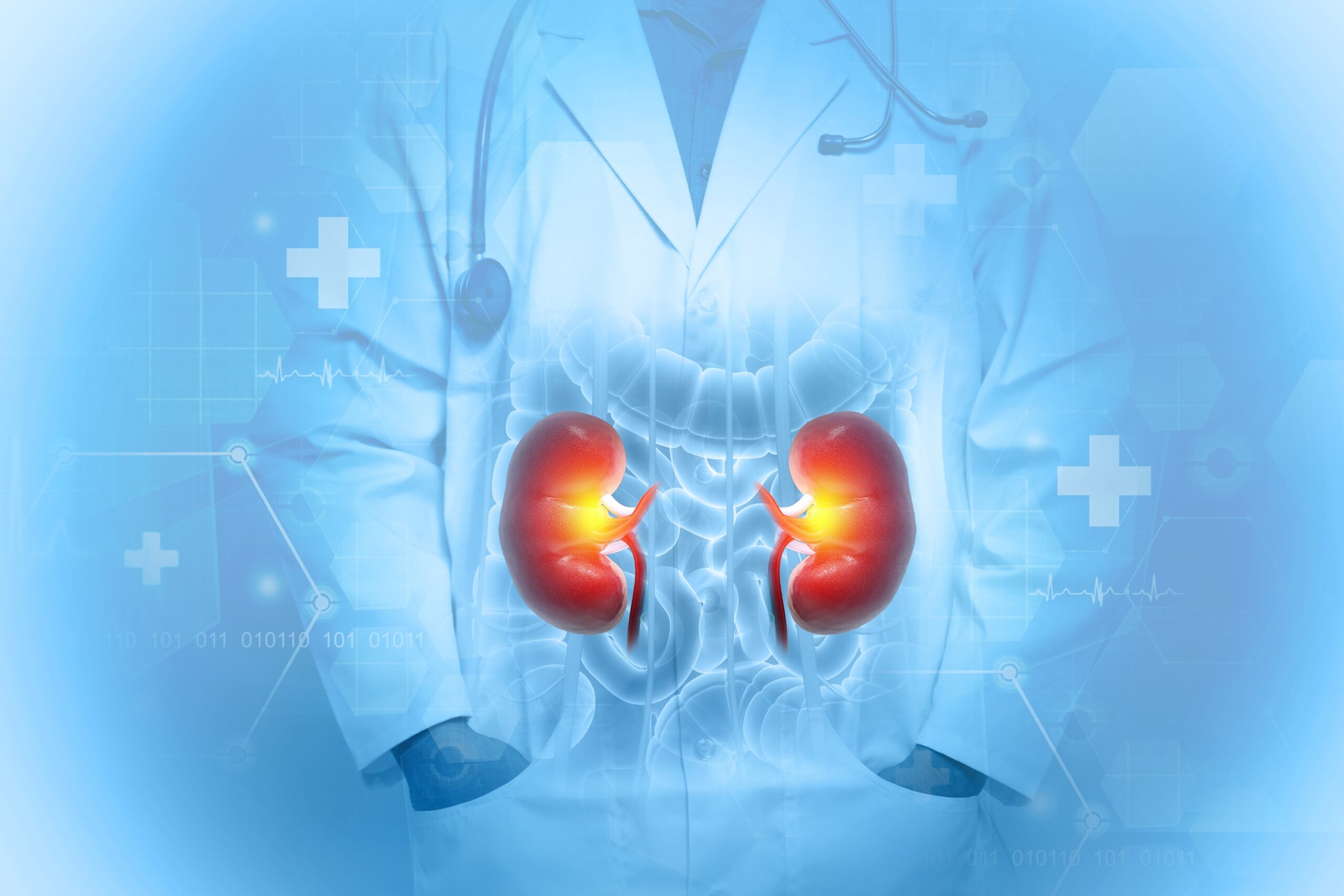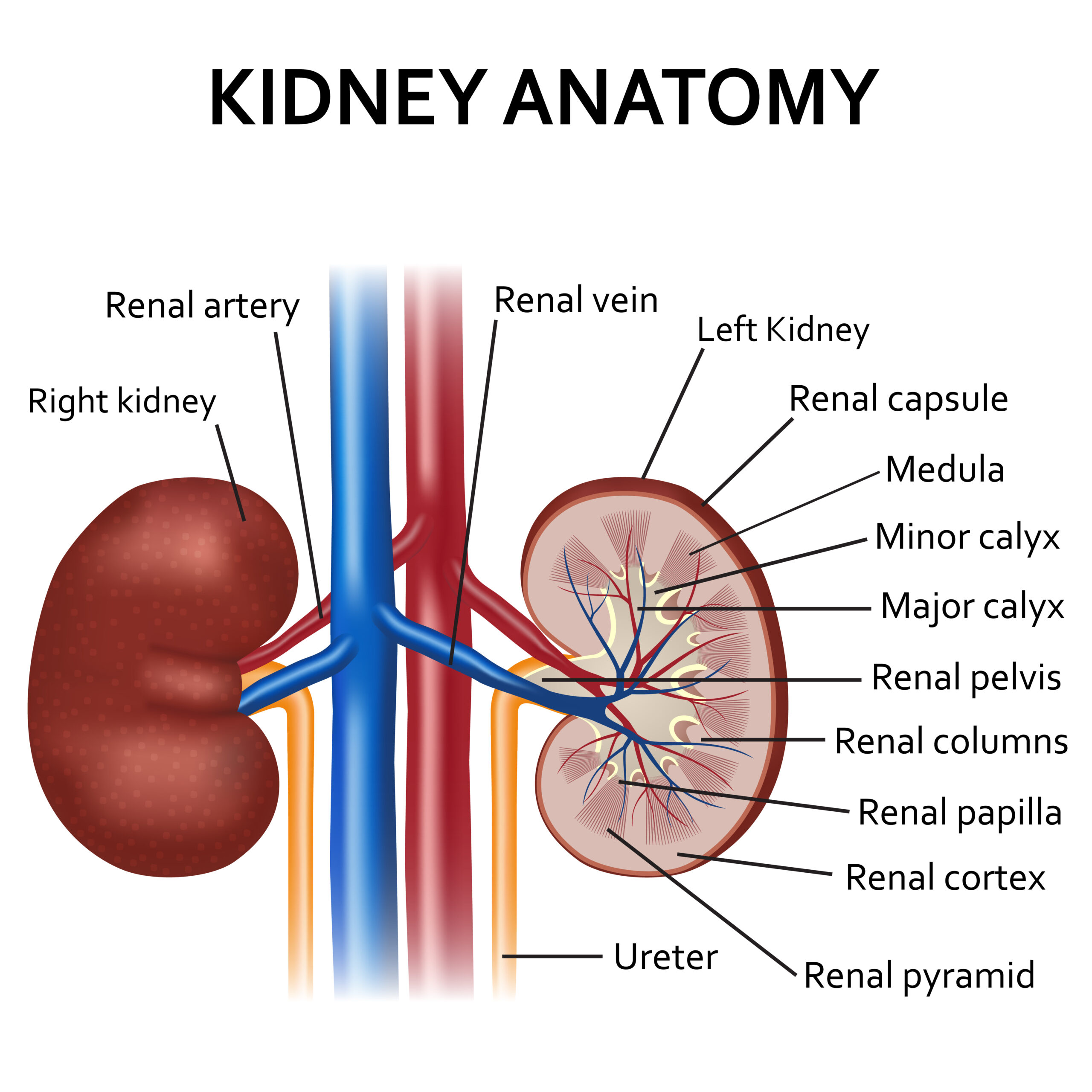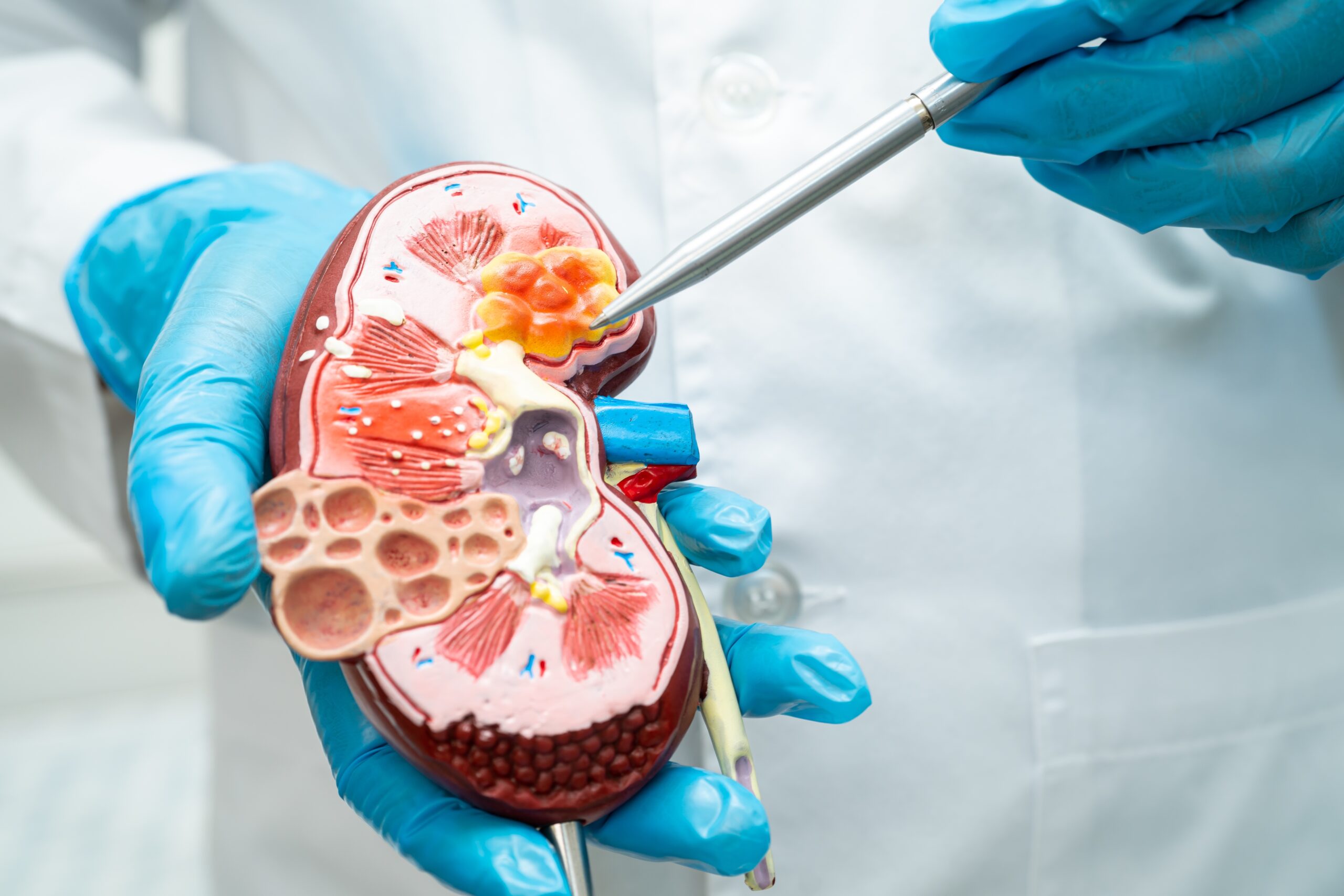Kidneys are bean-shaped organs placed below the ribcage. They are critical urinary system organs that filter harmful substances from the body and retain the most valuable ones. Without their work, the body would not be able to function correctly.
Those organs filter around half a cup of blood every minute, removing wastes and extra fluid from the body and producing urine. Thanks to them, the body maintains the balance of water, electrolytes, and salts. The primary unit of this organ is nephrons, and there are about a million of them in each kidney.
Common conditions affecting kidneys include nephropathy, cysts, and kidney failure.

Kidneys play several essential roles in the proper working of the body. The most important ones include:
The body absorbs nutrients from food and uses them differently, leaving unnecessary products. The kidneys cleanse the blood of toxins, excess salts, urea (a protein breakdown product), creatinine (a product of muscle breakdown), and other unnecessary metabolic products.
This vital process for the body takes place in the nephrons. In the so-called glomeruli, excess water and unnecessary metabolic products are removed from the blood in their initial fragment. This is where primary urine is produced. Then, in the middle part of the nephrons, water and electrolytes valuable for the body are recovered from the urine. In the final part, the urine becomes concentrated and flows through the ureters to the bladder.
To filter blood, it first must flow into the kidneys in a large vessel called the renal artery. Inside the kidney, the artery divides into smaller and smaller arteries until reaching the tiniest vessels, which play a direct role in filtration. After filtration, blood returns through the renal vein.
In addition to their filtering function, the kidneys act as regulators, responsible for maintaining harmony inside the body, the so-called homeostasis![]() . Thanks to them, all organs can work in constant, optimal conditions for maintaining health.
. Thanks to them, all organs can work in constant, optimal conditions for maintaining health.
They regulate hormonal and electrolyte balance (the organs ensure the appropriate amount of sodium and potassium) and control the body's water level. When you have too much of it, it transports more water from the blood into the urine. When you are dehydrated, for example, through vomiting or diarrhea, its excretion in urine decreases.
Those organs also regulate blood pressure. Thanks to the production of vitamin D3, they influence calcium and phosphate metabolism and, therefore, the condition of the bones. They produce erythropoietin, a protein that stimulates the bone marrow to produce red blood cells, which transport oxygen to all body tissues and organs.
The organs are localized at the back of the abdomen, below the ribcage, under the diaphragm, and above the intestines. In normal conditions, one kidney is on the right side of the spine, and the other is on the left. The left organ is slightly higher than the right one. Each organ is reddish-brown and about 12 centimeters![]() long, around the size of a fist.
long, around the size of a fist.
The kidneys are composed of the cortex and the medulla. The cortex is the outer layer where nephrons begin. Nephrons are the blood-filtering units. In the cortex, erythropoietin is produced, a hormone necessary for red blood cell production. The second part, the medulla, is the inner part of the organ, which contains the rest of the nephrons with glomeruli and renal tubules.
Each kidney has over a million![]() nephrons, which are filtering units. Each nephron is built of:
nephrons, which are filtering units. Each nephron is built of:
The organs are surrounded by a fibrous layer called a renal capsule. The renal capsule is built of three connective tissue layers and fat. Its job is to protect your kidneys from getting injured and connect them to the other tissues.
The kidneys are well supplied with blood, which comes into the organ through the renal artery and leaves through the renal vein. The renal artery pumps more than 1 liter![]() of blood through the organ each minute.
of blood through the organ each minute.
Urine is transported from the renal tubules into the pyramid-shaped structures called renal papilla. Renal papilla connects, creating a structure called the renal pelvis. This structure collects urine and moves it down to the two ureters. Next, the urine goes to the urinary bladder from the ureters, where it is stored.

Kidney conditions are a large group of diseases. They include kidney failure, glomerular disease, IgA nephropathy, amyloidosis, cysts, kidney stones, and many others. Each of those conditions has different causes, symptoms, and treatment options. How can you notice a kidney condition? Here’s the information about the most common diseases that affect that organ.
Failure of this organ occurs when one or both of them stop working well enough on their own. This condition has two types: long-lasting (chronic) and acute. Chronic failure may develop slowly and gradually worsen, while the acute![]() form develops quickly and may be temporary.
form develops quickly and may be temporary.
The symptoms include:
Without treatment, the condition is fatal. The doctors diagnose it using various tests that enable them to evaluate the organ’s function. Those include:
Two options are available to treat this condition: dialysis and organ transplant. Dialysis uses a machine to clear your blood from waste. Depending on the advancement of the disease, dialysis takes place three to four times a week. In the case of an organ transplant, the healthy organ can come from a deceased donor or living donor since a human can live with one kidney.
Berger disease is an autoimmune disease caused by antibodies![]() that fight germs (immunoglobulins A) building up in the kidney. Antibodies deposits cause inflammation and damage the organ, leading to scarring. As a result, nephrons get destroyed, and blood and protein may get into your urine.
that fight germs (immunoglobulins A) building up in the kidney. Antibodies deposits cause inflammation and damage the organ, leading to scarring. As a result, nephrons get destroyed, and blood and protein may get into your urine.
The symptoms include:
IgA nephropathy can’t be cured, but treatment can delay or prevent organ damage. Doctors use various medications, lifestyle changes, and dialysis to treat the condition.
Glomerular disease destroys glomeruli, structures that clean blood from waste. Damaged glomeruli allow substances that shouldn’t get into urine to pass. This condition can be caused by diabetes, autoimmune diseases, such as lupus and Goodpasture’s disease, infections, and some genetic conditions, such as Alport’s syndrome.
Glomerular disease![]() often does not cause any symptoms, but it always causes abnormal urine test results. Usually, it is an abnormal result of a routine urine test that indicates the presence of the disease. A urine test shows protein and blood (red blood cells), which should generally be absent. If you have this condition, you may notice that the urine is foamy (if the amount of protein in the urine is high) or abnormal in color (pink or red if it contains a lot of red blood cells). There may also be pain in the kidney area.
often does not cause any symptoms, but it always causes abnormal urine test results. Usually, it is an abnormal result of a routine urine test that indicates the presence of the disease. A urine test shows protein and blood (red blood cells), which should generally be absent. If you have this condition, you may notice that the urine is foamy (if the amount of protein in the urine is high) or abnormal in color (pink or red if it contains a lot of red blood cells). There may also be pain in the kidney area.
The treatment of the condition depends on the disease’s cause, symptoms, and advancement.

Amyloidosis is a severe systemic condition caused by the accumulation of amyloid, an abnormal protein produced by the ill body, in many organs. Amyloid builds up between body cells, damaging essential organs such as the heart, kidneys, liver, intestines, and nerves.
Amyloidosis typically manifests as:
Often, the disease is diagnosed late, when the organ changes are already advanced. Damage to various organs may raise a physician’s suspicion of amyloidosis. The test that allows the doctor to diagnose renal amyloidosis is a biopsy. Amyloid![]() deposits present in the organ are visible under a microscope.
deposits present in the organ are visible under a microscope.
It is not always necessary to perform a kidney biopsy. Amyloidosis may also be diagnosed if typical features such as proteinuria or renal failure are present in a person who has amyloidosis in other body tissues.
Currently, a complete cure for renal amyloidosis is not possible. However, several clinical trials have been conducted to research new medications to prevent the condition’s progression.
Renal artery stenosis occurs when one or both vessels carrying blood into the kidneys (renal arteries) are narrowed. As a result, the organ doesn’t receive enough oxygen-rich blood, and high blood pressure develops, often resistant to medications and starting before age 30.
The disease may be caused by atherosclerosis, a buildup of fats and cholesterol inside the artery wall, or fibromuscular dysplasia, when the artery wall grows incorrectly. Narrowing caused by dysplasia typically begins in childhood.
Polycystic kidney disease is a genetic condition that causes multiple fluid-filled cysts in the kidney. When a single cyst is present, it is usually harmless, but in polycystic disease, the condition changes the shape of an organ and reduces its function.
Symptoms of the condition are also its complications and include:
So far, there is no effective treatment for polycystic renal disease that would prevent or inhibit the development and enlargement of cysts and could significantly delay the onset of renal failure. Treatment aims to manage high blood pressure and other symptoms of the condition. Patients whose organs no longer function effectively require dialysis and, ultimately, transplantation.
Kidney stones are deposits (stones) in the urinary system made of chemicals that are usually found in urine. Typically, these substances are present in urine in dissolved form. Sometimes, however, their concentration is too high, and they do not dissolve completely.
A typical symptom of kidney stones is renal colic, which is sudden, extremely severe pain![]() in the back of the abdomen. The cause of renal colic is the movement of the stones to the ureter, which causes irritation and discomfort. Vomiting, nausea, and blood in the urine can accompany renal colic. If the described symptoms appear for the first time or are accompanied by fever or chills, you should see a doctor immediately.
in the back of the abdomen. The cause of renal colic is the movement of the stones to the ureter, which causes irritation and discomfort. Vomiting, nausea, and blood in the urine can accompany renal colic. If the described symptoms appear for the first time or are accompanied by fever or chills, you should see a doctor immediately.
Not all diseases can be prevented. However, there are steps you can take to care for your kidney’s health: